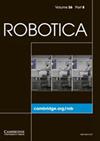将受电弓结构与钢板弹簧相结合的柔性支腿设计
IF 2.7
4区 计算机科学
Q3 ROBOTICS
引用次数: 0
摘要
摘要提出了一种柔性支腿结构,改进了传统的板弹簧受电弓设计。建议的配置具有以下特点:(1)由于使用受电弓结构,质量集中在髋关节周围,减少了下肢惯性;(2)选用钢板弹簧作为弹性件,提高了能量效率,估算了足端接触力。与螺旋弹簧相比,钢板弹簧不需要导轨展开,并且可以通过形状切割轻松调整其刚度。引入了分析模型来分析腿的刚度,并仅根据钢板弹簧的挠度估计接触力。基于所提出的设计,搭建了一个单腿机器人,并进行了各种实验。在刚度标定和接触力估计方面的实验结果与分析模型吻合较好。跌落实验证明了腿具有类似弹簧行为的可行性。周期性跳变实验证明了利用弹簧挠度检测着陆事件的可行性。在能效方面,我们还观察到,与用刚性材料代替钢板弹簧的腿相比,弹性腿在飞行阶段的跳跃高度增加了20%。本文章由计算机程序翻译,如有差异,请以英文原文为准。
A compliant leg design combining pantograph structure with leaf springs
Abstract We proposed a compliant leg configuration that enhances the conventional pantograph design with leaf springs. The following facts characterize the proposed configuration: (1) Due to the use of the pantograph structure, the mass is centralized around the hip joint, reducing the lower leg inertia; (2) Leaf springs are chosen as elastic parts to increase energy efficiency and estimate foot-end contact forces. Compared with coil springs, leaf springs require no guide rails to deploy, and their stiffness can be easily adjusted through shape cutting. Analytical models are introduced to analyze the leg’s stiffness and estimate the contact forces only with the deflections of leaf springs. A one-leg robot based on the proposed design is built, and various experiments are conducted. Experiments regarding the stiffness calibration and the contact forces estimation showed an acceptable agreement with the analytical model. Experiments of dropping demonstrate the feasibility of the leg to perform spring-like behaviors. Experiments of periodic hopping demonstrate the feasibility of using spring deflections to detect touch-down events. For energy efficiency, it is also observed that the elastic leg has a 20% increment concerning the jumping height in the flight phase, compared with the one where leaf springs are replaced with rigid materials.
求助全文
通过发布文献求助,成功后即可免费获取论文全文。
去求助
来源期刊

Robotica
工程技术-机器人学
CiteScore
4.50
自引率
22.20%
发文量
181
审稿时长
9.9 months
期刊介绍:
Robotica is a forum for the multidisciplinary subject of robotics and encourages developments, applications and research in this important field of automation and robotics with regard to industry, health, education and economic and social aspects of relevance. Coverage includes activities in hostile environments, applications in the service and manufacturing industries, biological robotics, dynamics and kinematics involved in robot design and uses, on-line robots, robot task planning, rehabilitation robotics, sensory perception, software in the widest sense, particularly in respect of programming languages and links with CAD/CAM systems, telerobotics and various other areas. In addition, interest is focused on various Artificial Intelligence topics of theoretical and practical interest.
 求助内容:
求助内容: 应助结果提醒方式:
应助结果提醒方式:


